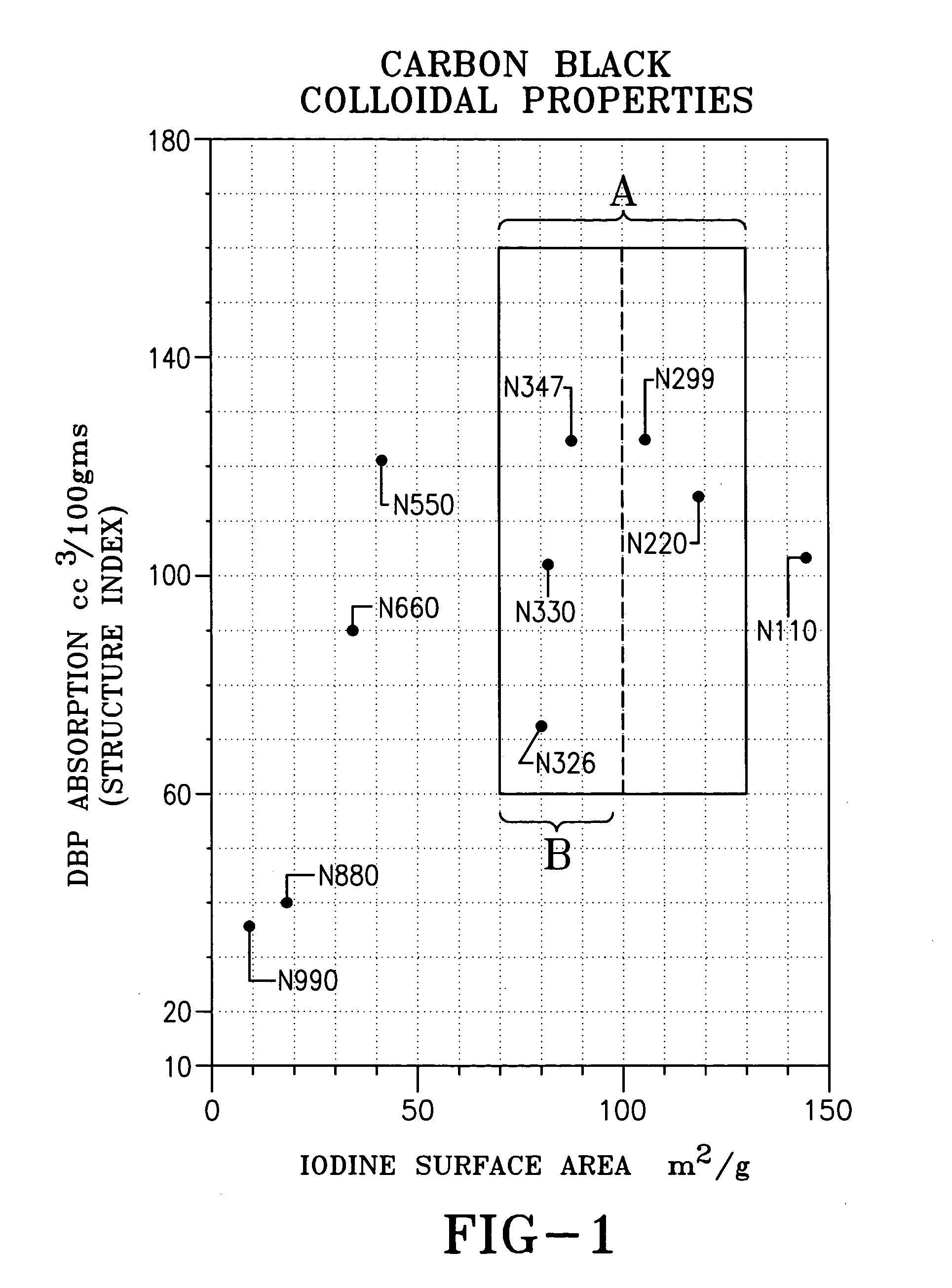Aircraft tire
a technology for aircraft and tires, applied in the field of aircraft tires, can solve the problems of significant rapid temperature rise, large propensity, and impact on the heat durability of tires, and achieve the effects of promoting a relatively smooth surface, promoting a relatively low hysteresis rubber composition, and promoting the processing of unvulcanized rubber compositions
- Summary
- Abstract
- Description
- Claims
- Application Information
AI Technical Summary
Benefits of technology
Problems solved by technology
Method used
Image
Examples
example ii
[0093] Samples of rubber compositions were prepared and referred to in this Example as Samples 3 and 4, with Sample 3 being a Control Sample.
[0094] Control Sample 3 contained cis 1,4-polybutadiene rubber and natural cis 1,4-polyisoprene rubber together with reinforcing filler as a combination of N347 rubber reinforcing carbon black (Box B of FIG. 1) and silica with its coupling agent.
[0095] Sample 4 contained a specialized cis 1,4-polybutadiene rubber and natural cis 1,4-polyisoprene rubber together with reinforcing filler as a combination of N347 rubber reinforcing carbon black (box B of FIG. 1) and silica with its coupling agent.
[0096] The rubber compositions were prepared in the manner of Example I.
[0097] The rubber compositions are illustrated in the following Table 3.
TABLE 3ControlMaterialSample 3Sample 4First Non-Productive Mix StepCis 1,4-polybutadiene rubber1800Specialized cis 1,4-polybutadiene rubber2080Natural rubber32020Carbon black (N347)44040Paraffinic and microcr...
example iii
[0102] Samples of rubber compositions were prepared and referred to in this Example as Samples 5 and 6, with Sample 5 being a Control Sample.
[0103] Control Sample 5 contained a specialized cis 1,4-polybutadiene rubber and natural cis 1,4-polyisoprene rubber together with reinforcing filler as N347 rubber reinforcing carbon black, illustrated in box B of FIG. 1 of the accompanying drawings. Sample 4 contained the specialized cis 1,4-polybutadiene rubber and natural cis 1,4-polyisoprene rubber together with reinforcing filler as the N347 rubber reinforcing carbon black together with precipitated silica with its coupling agent.
[0104] The rubber compositions were prepared in the manner of Example I.
[0105] Ingredients used in the rubber Samples are illustrated in the following Table 5.
TABLE 5ControlMaterialSample 5Sample 6First Non-Productive Mix StepSpecialized cis 1,4-polybutadiene rubber17575Natural rubber22525Carbon black (N347)35540Paraffinic and microcrystalline wax41.51.5Rubb...
example iv
[0112] Samples of rubber compositions were prepared and referred to in this Example as Samples 7 and 8, with Sample 7 being a Control Sample.
[0113] Control Sample 7 contained a specialized cis 1,4-polybutadiene rubber and natural cis 1,4-polyisoprene rubber together with reinforcing filler as a combination of N2O5 rubber reinforcing carbon black (box B of FIG. 1) and silica with its coupling agent.
[0114] Sample 8 also contained a specialized cis 1,4-polybutadiene rubber and natural cis 1,4-polyisoprene rubber together with reinforcing filler as a combination of rubber reinforcing carbon black and silica with its coupling agent but used an N347 rubber reinforcing carbon black (box A of FIG. 1) instead of the N2O5 carbon black reinforcing filler of Control Sample 7.
[0115] The rubber compositions were prepared in the manner of Example I.
[0116] The rubber compositions are illustrated in the following Table 7.
TABLE 7ControlMaterialSample 7Sample 8First Non-Productive Mix StepSpecia...
PUM
| Property | Measurement | Unit |
|---|---|---|
| storage modulus | aaaaa | aaaaa |
| BET surface area | aaaaa | aaaaa |
| temperature | aaaaa | aaaaa |
Abstract
Description
Claims
Application Information
 Login to View More
Login to View More - R&D
- Intellectual Property
- Life Sciences
- Materials
- Tech Scout
- Unparalleled Data Quality
- Higher Quality Content
- 60% Fewer Hallucinations
Browse by: Latest US Patents, China's latest patents, Technical Efficacy Thesaurus, Application Domain, Technology Topic, Popular Technical Reports.
© 2025 PatSnap. All rights reserved.Legal|Privacy policy|Modern Slavery Act Transparency Statement|Sitemap|About US| Contact US: help@patsnap.com


